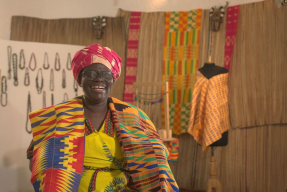by Josh Weinstein, KF9 Philippines
I spent the last three days in “the field,” a term used to describe the front lines of microfinance where the money is distributed to the clients of the MFI. Beginning early Tuesday morning, I set out for the town of Valladolid, a rural municipality about 50 km from Bacolod City. The road snakes along the coast through increasingly less urban communities, until reaching Pontevedra, where the NWTF (Negros Women for Tomorrow Foundation) Valladolid branch is located. The branch manager, Linda Saraet, took me to see the first of 15 borrowers we would try to track down over the course of the three-day trip (with a 67% success rate). Riding in the metal grates on the back of a tricycle, where I’d spend most of my trip, we rode to a small village called a barangay to interview several women about their business and loan. The community here is small, and stopping for directions usually produced a friendly guide that brought us directly to the home of the borrower. Home constructions vary from 2-3 room nipa huts – bamboo structures with thatched roofs and dirt floors – to cement frames with roofs of corrugated aluminum. Sometimes the house has electricity and running water, sometimes not. Over the course of the week, I’d see all types represented. Housing loans are popular among borrowers, and many homes have been built with loans from NWTF.
In the afternoon, we stopped by a center meeting to observe the weekly loan collection process. NWTF is patterned after Muhammad Yunus’ Grameen Bank, utilizing the solidarity lending methodology pioneered in Bangladesh. Women organize into groups of five, typically according to friendship and family ties. These groups agree to guarantee one another’s loans, so it is important that they are close. Five or six of these groups come together to form a center, which range from 25-50 women. Each branch covers 50-80 centers, for a total of ~250,000 clients nationwide. The members elect a center chief and deputy center chief, who are responsible for ensuring attendance at the meetings and guaranteeing weekly repayment. NWTF offers an incentive of 1,200 pesos (~$300) per month to groups with perfect attendance and repayment. This money can be redistributed to the group, or put toward building a meeting center, which is typically an open-air bamboo structure with rows of benches for the women to sit and a table to conduct business. Each center is assigned a loan officer. The loan officer collects and verifies repayment, runs the center meetings, approves new loans, and generally keeps the group on track. Each branch is run by a former loan officer – in the case of Valladolid branch, our guide, Linda.
At each meeting we attended, the women took turns introducing themselves, explaining their businesses, and discussing their dreams. 80% of the businesses are either sari-sari stores, pig-fattening, or owning a motorcycle. Some women grow rice, others have more extensive farming operations. For most, the dream is to send their children to college. One after another, the borrowers expressed their desire to send their 3, 4, 5, or more children to university in the city. And for the most part, these women were successful, with the help of a loan from Project Dungganon, NWTF’s microcredit loan program. With financial assistance through a special loan, these women have built homes, sent their children to school, expanded their businesses, and put other members of the community to work.
In August of 2009, the Boston Globe had an article on microfinance in its Ideas section titled “Small Change,” which highlighted studies from several prominent economists about the efficacy of microcredit in alleviating poverty. The basic premise of the article is that, while the narrative of innate entrepreneurial spirit and success through discipline in microfinance is appealing, it actually has a marginal impact on sustained poverty alleviation, and belies the truth about the “economic ladder.” The article discusses the findings of MIT’s Jameel Action Poverty Lab:
What they find is that, by most measures, microcredit does not offer a way out of poverty. It helps a few of the more entrepreneurial poor to start up businesses, and at the margins it may boost the profits of existing microenterprises, but that doesn’t translate into gains for the borrowers, as measured by indicators like income, spending, health, or education.
In other words, microfinance may empower entrepreneurs, but it doesn’t create the small- and medium-sized enterprises that produce steady jobs. When I asked some folks at Kiva their thoughts on the article, the answer was always the same: “they’ve never been to the field.” The answer always felt like a cop-out, as if there should be an empirical rebuttal to the argument. But I understand now what they meant. At the final center meeting I attended, three women were reduced to tears recounting how Project Dungganon and NWTF had changed their lives; how their children were in Bacolod or Manila or some other faraway city studying information management or computer science. More than half had children in college, or were saving for the future. What I realized is that the key to sustainable poverty alleviation is education. To the women of NWTF, it is the children who reap the benefits of a Dungannon loans, directly and indirectly. It may take a generation before the lasting impacts of microfinance become evident. Perhaps they never truly will. But the last three days have given me faith that, 20 years from now, when the children are grown, the landscape of the communities I visited will look very different, the sweet fruits of microfinance finally on full display.
Please support the women of NWTF and help them achieve their dreams of educating their children for the future here.
/>PREVIOUS ARTICLE
"Companies That Care" Matches $15,000 in Support of Kiva →NEXT ARTICLE
Three Interesting Borrowers →















